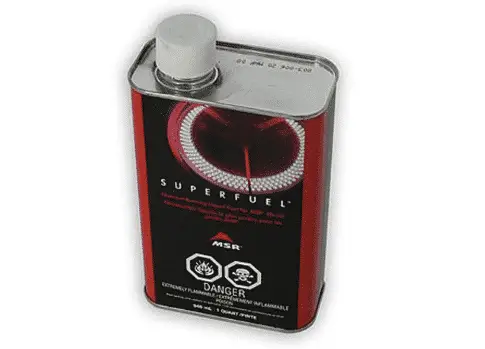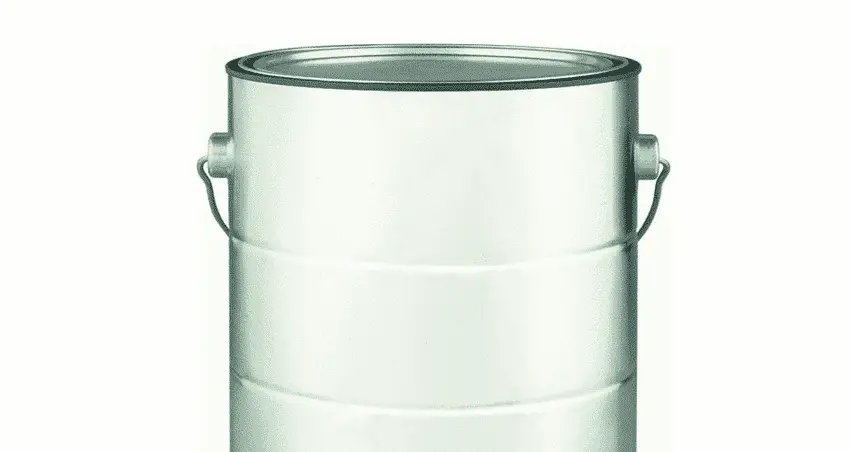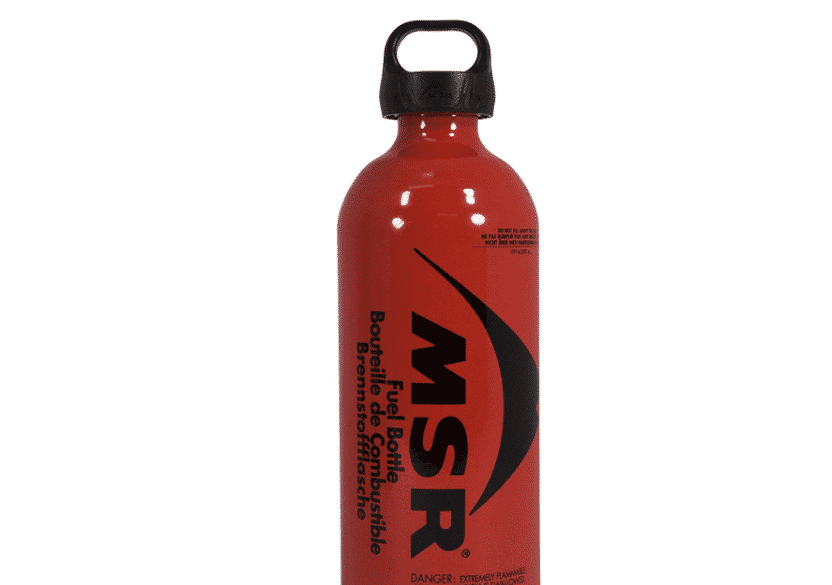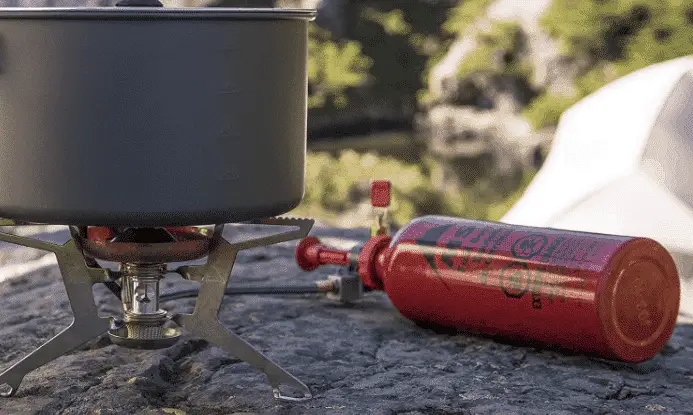Choosing the right camping fuel is always a tricky subject. Nobody can seem to agree on the best fuel. Some fuels are just going to be easier to use than others.
White gas is by far one of my favorite stove fuels, but storage can be a problem. It burns hot, fast and is reliable in cold temperatures, but storage is a pain. So how do you store white gas camping fuel?
Table Of Contents
How to Store White Gas Camp Fuel
Anybody that’s tried white gas instantly falls in love. Once you figure out the pressure system you’re off to the races. It has a consistent hot burn that’s guaranteed to light.
It’s a highly refined fuel with no fuel additives, so it will last for years. You just have to know how to properly store it. Keep it in the original container, and you eventually end up with a bunch of half-used containers.
Problems start to arise when you start storing it in other containers, but how do you store it? How do you make sure the gas is safe in long term storage.
- Keep the container tightly sealed to avoid spills. Try to separate the fuel from the rest of your pack just in case.
- Make sure you label the fuel if you’re transferring it into another container. Write down the exact blend and the approximate date it was purchased. White gas camp fuel can last way longer than gasoline so this isn’t that big of a deal, but you might have combustion issues at altitude and cold temperatures.
- On short weekend trips use small liquid fuel containers(On Amazon). All you really need is 1 liter of fuel for most short trips. Never use plastic bottles to store white gas; they will eventually leak.
Safe Containers to Store White Gas
When storing gas there’s a fine line between safe and downright dangerous. You can’t just pour white gas in any old container and hope for the best. For long term storage, you need to make sure the containers are airtight and hazmat safe.
As long as these containers are kept away from excess heat it should be safe long term. Just make sure you keep the white gas in a cool dry place away and don’t bring it into the house.
Once you’ve chosen white gas as your primary fuel source, you’ll need to know how to store it! Here are my favorite containers for storing white gas long term.
Original Container

Just stick to the original container if you can. These containers were designed for long term fuel storage. They are specifically designed for long term storage and transport.
In the original container, your fuel should last for at least 10 years. Just make sure you’re storing it safely. It needs to be kept away from your living quarters in the garage away from heat and sparks.
Some people claim that the fuel degrades after it’s been opened, but I haven’t found that to be true.
Another huge advantage to using the original container is you always know exactly what you’re using. In the decade or so companies have been making premium blends that supposedly work better in certain environments.
These blends are great in the short term, but the additives tend to shorten the usable shelf life. It’s always nice to know exactly what you’re burning and how it’s going to perform.
Paint Can

On longer camping trips you might want to transfer fuel into paint cans. They’re kind of a pain in the butt to transport, but you can hold way more fuel.
You can hold 4 quarts of White Gas in a single gallon paint can. Being able to consolidate your fuel into 1 container seriously cuts down on weight and overall storage volume.
Plus you won’t end up with a bunch of half-full fuel canisters in storage. I always end up with a bunch of partially full cans that you just don’t want to take out, but there’s too much fuel to waste.
You could always take out a siphon and transfer into the original container, but it’s much easier to pour these in a paint can. They can be nicely re-sealed with basic tools. Just make sure you label the can with the exact fuel-type and the date it was stored.
Liquid Fuel Bottles

On short overnight trips you might want to consider one of those small liquid fuel bottles(my favorite on Amazon). These containers are a little smaller than your typical water bottle and very easy to transport/store in your pack.
Plus they attach directly to your camp stove so there’s absolutely no waste. Just bring along a couple of full fuel bottles and you’re good to go. You don’t have to carry around a bunch of empty fuel containers to dispose of when you get home.
The Worst Containers to Store White Gas
White gas is a seriously corrosive substance so you need to be careful. Never store gas in a plastic container that could potentially leak or melt. Even containers labeled for gas usually aren’t suitable for long term storage.
Water Bottles
It’s just an overall bad idea to store gas in water bottles. They leak, break down and you run the risk of accidentally consuming fuel. You could end up accidentally drinking the fuel when you’re not paying attention (trust me it burns).
I used to store gas in a plastic Nalgene bottle which worked well, but that didn’t end well. Not only did I accidentally take a sip of gas on more than 1 occasion, the bottle eventually wore down and ruined my pack and all my gear.
The thin plastic found in water bottles just isn’t durable enough to store white gas. It will probably work in the short term, but you’ll eventually end up with a mess.
Glass
White gas isn’t going to destroy glass, but you will eventually shatter the container. I used to use those glass Snapple bottles for short term gas storage and they worked great.
I was careful, never dropped them and thought I was good to go. They never went in my pack or rolled around in the back of my car. Eventually, I realized the error of my ways.
Once the cold weather hit my glass bottles started to shatter every time I touched them. My body heat touching the glass forced the glass to expand and instantly shattered cutting my hands and drenching me in gasoline. Imagine what could have happened if there was an open flam nearby.
Gas Cans
Obviously gas cans are meant for liquid fuel storage, but they aren’t designed for transporting gas. They have a tendency to leak and you’ll end up with a trunk full of white gas. Even if it doesn’t leak you’ll end up with gas fumes in your car, which nobody wants.
Long Term White Gas Storage
It’s really hard to tell just how long white gas isn’t going to last. It all depends on what
Generally speaking, white gas will last at least 1 year without noticeable degradation. Opening up the container will supposedly shorten the stable shelf life for a few months.
Where to Store White Gas
You need to be careful when putting white gas into long term storage. It’s important to know exactly where, when and how much gas you’re storing.
White gas is a hazardous substance that’s highly combustible so you can’t just store it anywhere. So you need to make sure it’s stored away from your general living area and out of reach of children/pets.
Keep it in a cool dry place away from common heat sources. In your garage cabinets or storage shelf is perfect. This might not be as convenient as storing with your camping gear, but it’s much less risky. You won’t have accidental spills which are dangerous and might even ruin your gear.
Things to Avoid
This is all about using a little bit of common sense. White gas is highly combustible so storage shouldn’t be taken lightly. Never store gas in an area with excess heat and the occasional spark.
In high school, one of my friends set their garage on fire with an accidental spark. They were grinding something down and a spark lit up a gas covered rag. This is obviously a worst-case scenario, but it does happen.
How Long Does White Gas Last?
Generally speaking, pure white gas usually lasts at least 1 year after opening. In an ideal environment (warm weather, low altitude) this shelf life can be extended. White gas that hasn’t been opened can usually last a few years.
Things get a little tricky when comparing premium blends like Coleman Premium Blend Fuel (On Amazon). These products use fuel stabilizers which extend the shelf life of the fuel to about 5-10 years. These products burn hot, but could potentially clog/damage your stove.



